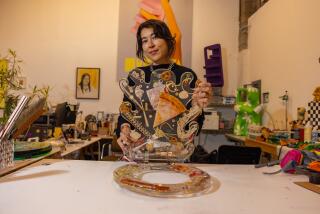Hottest seat in town
MAYBE the problem is the name. Bidet. Rhymes with ballet. Sounds altogether too French, fussy and feminine.
Or maybe it’s the shape, the low profile that can look like a miniature tub for washing the feet or an infant -- a silly and ultimately extraneous bathroom fixture.
Whatever the reason, Americans have remained suspicious of the 300-year-old invention whose name is derived from the old French word for “to trot,” a reference to the fact that one straddles the apparatus. The very idea still makes some people giggle.
But hold onto your toilet seat. With the introduction of high-tech bidet seats that can be retrofitted to existing toilets, products such as Toto’s Washlet and Brondell’s Swash are gradually becoming standard equipment in high-end homes.
One of the selling points: environmental friendliness. Though the bidet does increase water usage slightly, it can reduce the use of toilet paper by 50% to 90%, according to Brondell. That may not seem significant until one realizes that Americans use more than 3.2 million tons of toilet paper annually, cutting down 54 million trees in the process. The production of each roll requires an average of 1 1/2 pounds of wood, 37 gallons of water and 1.3 kilowatts of energy, and it involves toxic chemicals such as chlorine.
--
‘BY every objective measure, it’s better to clean yourself with water than paper, but objectivity doesn’t always fly in this realm,” says Dave Prager, author of “Poop Culture: How America Is Shaped By Its Grossest National Product.” “There’s more at work here than logic.”
Indeed, the bidet’s acceptance hasn’t been quick or easy. Toto developed the retrofitted toilet seat-bidet combo in 1980. The product found its way into nearly 70% of Japanese homes, and even onto JAL and ANA airplanes.
Only recently have Toto Washlets been installed in any significant number in the U.S. Among the earliest adopters were high-end lodgings: Four Seasons, W Hotels, the Peninsula in Beverly Hills. Now dancers backstage at the Lincoln Center have them. So do the desk jockeys at Google’s corporate headquarters in Mountain View, Calif.
Americans are simply reluctant to change their habits, says Scott Pinizzotto, the mechanical engineer who co-founded Brondell with Internet entrepreneur David Samuel. He had been working for Sony in Japan in the 1990s and wondered why a fixture that was standard in that country was used so infrequently in the U.S.
“The idea of using water to wash with makes sense from a hygienic and comfort standpoint, but Americans haven’t grown up with it,” he says. “We’re a society of toilet paper users. That’s all we’ve ever known.”
He cites a fear of contamination but says that’s more perception than reality. Like Toto, Brondell uses a double-wand, twin-nozzle system for separate male and female use, and a self-cleaning process filters the water, making it “cleaner than the water you brush your teeth with,” he says.
Bidet-toilet combos are more expensive than standard toilets. Brondell, based in San Francisco, has Swash models running from about $450 to $800. Toto’s Washlet series goes from about $725 to $1,900.
Both companies have models with wireless remote controls that allow users to heat seats and customize water temperature and pressure.
The high end for your rear end? Check out the $5,000-plus tankless Toto Neorest 600, which comes with infrared sensors that lift the toilet seat upon approach and flush automatically when you’re done.
Less expensive, do-it-yourself gadgets from Biffy and USA Bidet mimic the Toto and Brondell models -- some for as little as $80 -- but you get what you pay for. No heated seat, no oscillating water pressure, no remote control.
--
DESIGNER Tim Corrigan says he always asks clients if they would like a bidet.
“I lived in Europe for seven years, but a lot of Americans don’t really understand what the purpose is,” Corrigan says, adding that most of his firm’s projects are in the $5 million-to-$20 million range, and bidets are all but expected. “It’s like the double Sub-Zero fridge in the kitchen: When we put them in, both the husband and wife really love them, but it’s not something they would ever have thought of putting in initially.”
Pro skateboarder Reese Forbes and his wife, Shawn, are two converts. They’ve been remodeling their 1960s midcentury modern home in Sherman Oaks and have added a Swash to the main bathroom.
“I’ve traveled extensively for the last 10 years and have always wanted one in my house,” Reese says. “Initially it’s a lot of technology coming at you that doesn’t make sense when you’re on the toilet, but when the seat heats up, then you know you’re in for a ride. Now I want another one for the master bathroom because it’s so disappointing in comparison.”
A bidet probably seems like a silly luxury to most Americans, Shawn says, but once you have one . . .
“It’s craziness. It’s so good,” she says. “And what can I say about a warm toilet seat? It’s the best thing ever.”
World Toilet Day is Monday. Celebrate in style.
--
More to Read
Inside the business of entertainment
The Wide Shot brings you news, analysis and insights on everything from streaming wars to production — and what it all means for the future.
You may occasionally receive promotional content from the Los Angeles Times.








